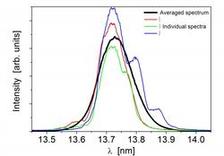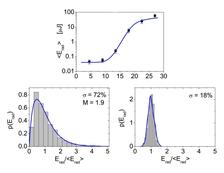The measured spectra of individual SASE FEL pulses at an average wavelength of 13.73 nm. The single-shot spectra show two to three peaks which fluctuate in size, position and height from shot to shot. The average spectrum of 100 FEL pulses is wider than the individual spikes. Its shape is in agreement with theoretical predictions.
For wavelengths in the ultraviolet and X-ray regime the start-up of the FEL process by seed radiation is difficult due to the lack of suitable lasers. In principle it can be done by choosing
a high harmonic of optical laser radiation. The process of Self-Amplified Spontaneous Emission (SASE) permits the start-up at arbitrary wavelengths without the need for external seed radiation. The most intuitive explanation of SASE is that the electrons produce spontaneous undulator radiation in the first section of a long undulator magnet which then serves as seed radiation in the main part of the undulator.
The emission of spontaneous undulator radiation is a stochastic process, and thus the SASE process is characterized by fluctuations in wavelength and FEL pulse energy. In the exponential gain regime the pulse energy fluctuations are quite large, in the order of 70 percent in a recent FLASH measurement at a wavelength of 13.7 nm. When saturation is reached the fluctuations drop to less than 20 percent. The origin of these fluctuations is easy to understand. The section in which the spontaneous radiation is produced may comprise typically 100 undulator periods corresponding to a bandwidth of 1 percent. If several electrons radiate independently the wavelength may therefore fluctuate by up to ±1 percent. Moreover, the longitudinal position at which an electron emits its radiation will vary from particle to particle. The radiation which is emitted first profits most from the exponential amplification, while radiation starting at a later position will be lower on the gain curve. In the end, only a few of the initial radiation modes will survive because they absorb the lion’s share of the energy extracted from the relativistic electron bunch. Deep in the saturation region all excited modes will reach a plateau, and thus the FEL pulse energy variations will be much reduced.







